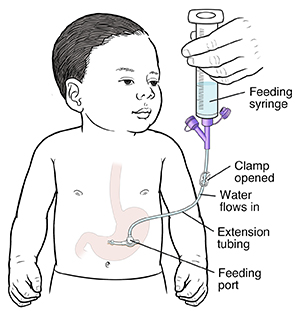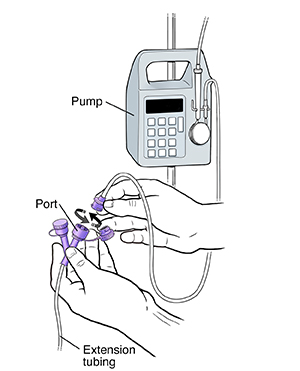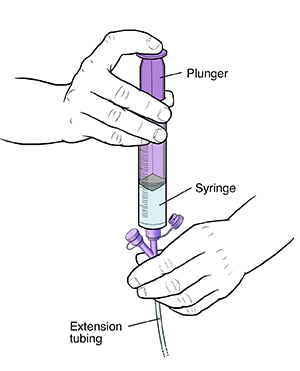Your Child's Gastrostomy or Gastro-jejunum Tube: Flushing the Tube
Your child is going home with a gastrostomy tube (G tube) or gastro-jejunum tube (G-J tube) in place.
Both G tubes and G-J tubes are placed through a small opening in the stomach. You will need to flush your child’s tube to keep it from getting clogged. You were shown how to do this before your child was discharged from the hospital. This sheet will help you remember those steps at home. If you need more help, talk with the hospital about how to arrange a home health nurse to help you.
Keep in mind that there are many types of G and G-J tubes, syringes, and feeding pumps. Your child’s tube and supplies may look or work differently from what are described and shown here. One type of tube has a connection that lets you plug or push the syringe into the G or G-J tube. Another type has a twist-on safety connector. The twist-on safety connector means you must use a certain type of syringe that twists onto your child's G or G-J tube. Follow your child's care team's instructions for your child's G or G-J tube.
Note
Take care to keep the feeding tube from becoming a strangulation risk to your child. Follow your healthcare team's advice on how to secure the tube safely.
Contact information to keep handy
Ask for phone numbers to call if you need help. Also make sure you have the phone number for your child’s medical supply company. You’ll need to order more supplies for your child in the future. Write all of these phone numbers below.
Healthcare provider phone number:
Home health nurse phone number:
Medical supply company phone number:
Flushing the tube using a syringe
Flush your child’s G or G-J tube after each feeding, or as often as instructed by your child’s healthcare provider.

The supplies you’ll need are:
Follow these steps:
-
Wash your hands with soap and clean, running water for at least 20 seconds. Dry them with a clean towel.
-
Make sure the extension tubing is connected to the feeding port and the feeding syringe is connected to the extension tubing. If there is a clamp on the extension tubing make sure it is open.
-
Pour water into the syringe. Let it run through the extension tubing by gravity.
-
If the water flows too slowly or doesn’t flow at all, place the plunger in the syringe. Gently push the plunger a bit. This can help remove anything that is blocking or clogging the G or G-J tube. Don't push the plunger all the way into the syringe or with force. Changing your child’s position so they are lying down or sitting upright may also improve the flow.
-
If there is a clamp on the extension tubing, close it once all the water has flowed through the tube.
-
Disconnect the syringe from the extension tubing.
-
Disconnect the extension tubing from the G or G-J tube.
-
Close the feeding port on the G or G-J tube.
-
Wash your hands with soap and water when done.
Additional instructions:
Flushing the tube using a pump
Flush your child’s G or G-J tube after each feeding, or as often as instructed by your child’s healthcare provider.


The supplies you’ll need are:
Follow these steps:
-
Wash your hands with soap and clean, running water for at least 20 seconds. Dry them with a clean towel.
-
Make sure the pump is in the STOP/OFF mode.
-
Close the clamp on the feeding bag tubing if there is one.
-
Disconnect the feeding bag tubing from the extension tubing.
-
Put the tip of the empty syringe in water.
-
Draw up 1 ml to 5 ml of water. The exact amount may depend on the age and size of your child, as well as your child’s condition. Talk with your child’s healthcare provider about the best amount for your child.
-
Connect the syringe to the extension tubing. If there is a clamp on the extension tubing, make sure it is open.
-
Gently push the plunger all the way into the syringe. If there is a clamp on the extension tubing, close it once all the water has been pushed out of the syringe.
-
Disconnect the syringe from the extension tubing.
-
Disconnect the extension tubing from the G or G-J tube.
-
Close the feeding port cap of the G or G-J tube.
-
Wash your hands with soap and water when done.
Other instructions:
When to call the healthcare provider
Call your child's healthcare provider right away if any of the following occurs:
-
The tube feels loose or comes out.
-
The opening where the tube enters the skin becomes larger.
-
Red, rough tissue forms around the tube site.
-
The tube becomes clogged or blocked and you can’t clear it.
-
The skin around the tube site has redness, swelling, leaking fluid, or sores.
-
You see blood around the tube, in your child’s stool, or in the stomach contents.
-
Your child coughs or vomits while feeding.
-
Your child’s belly looks bloated or feels hard when gently pressed.
-
Your child has diarrhea or constipation.
-
Your child has a fever of 100.4°F (38°C) or higher, or as directed by the healthcare provider.
Call 911
Call 911 if your child has trouble breathing or chokes while feeding or flushing.